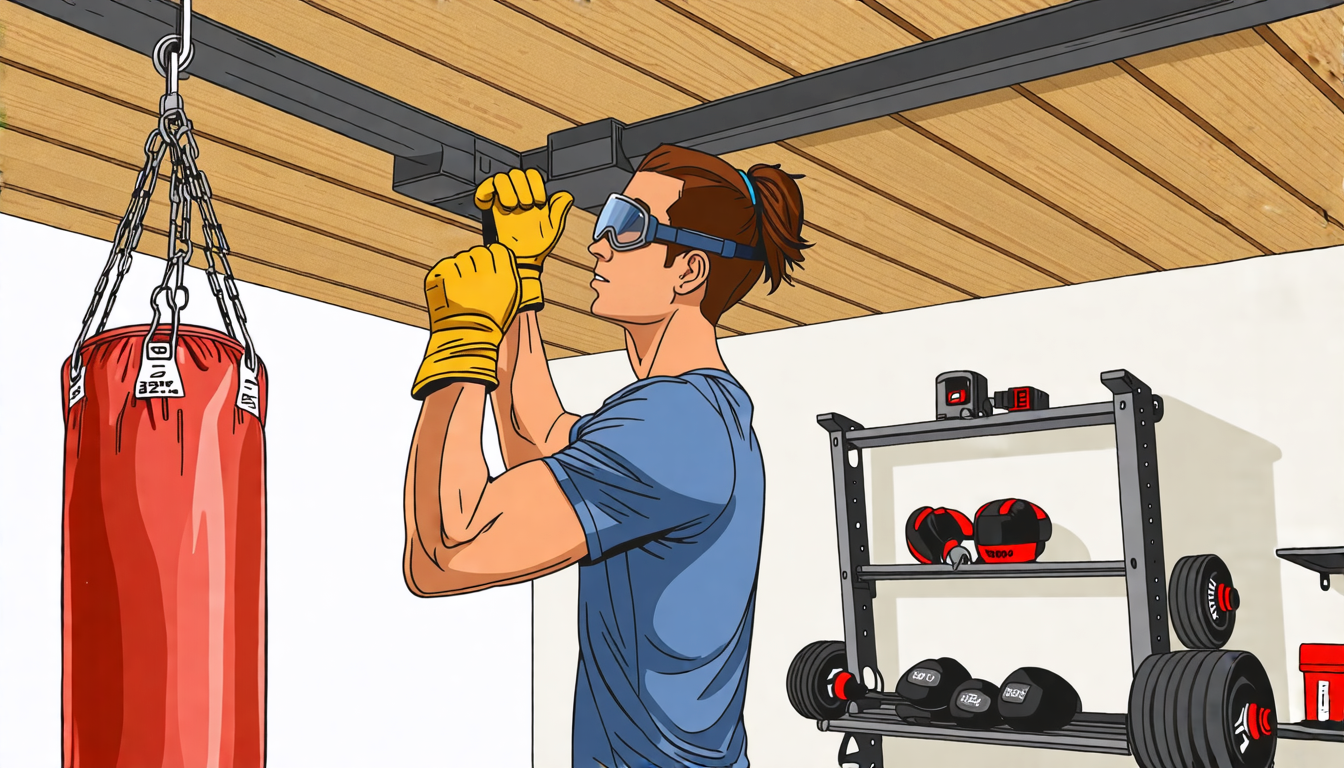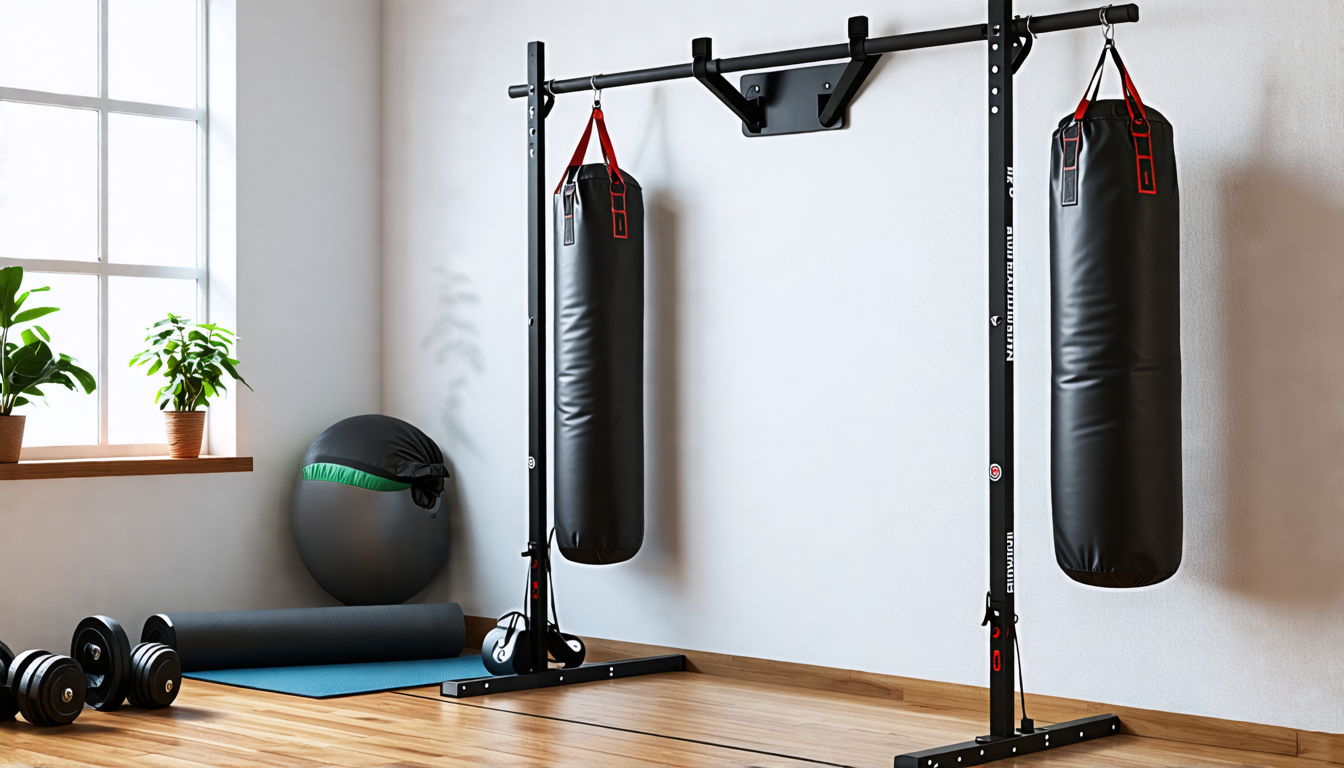If you’re looking to enhance your home fitness setup and are considering adding a punching bag, understanding whether you can attach it to your existing fitness bar is crucial. Fitness bars, often seen as the backbone of any home gym, serve multiple functions from pull-ups to supporting various attachments. However, before leveraging a fitness bar to support a punching bag, it’s important to grasp the basics of their design and ensure this alignment does not compromise safety or performance.
A fitness bar is typically designed to handle specific types of stress and weight, such as that from your body during a pull-up or a dip. The stability and functionality of these bars depend on how securely they are mounted, be it wall-mounted, ceiling-mounted, or stand-alone options. Types of fitness bars include doorway pull-up bars, wall-mounted rigs, and full power cages. Each has its own installation protocol and weight specifications, making it essential to assess whether they can safely support the additional dynamic load a punching bag creates.
Safety should always be your primary concern when altering your home gym setup. Begin with thoroughly checking the weight capacity of your fitness bar—most are built with a maximum weight load in mind. When considering adding a punching bag, you need to account not just for the static weight of the bag but also the dynamic motion which can significantly increase the strain on the installation. Ensuring secure fixtures and support systems is essential to prevent accidents and maintain the stability of your home fitness equipment.
Integrating a punching bag into your home fitness bar setup can add a dynamic workout dimension, but it requires meticulous planning and execution. By understanding the structural basics and adhering to necessary safety precautions, you can transform your home gym into a versatile fitness zone. Whether you’re a martial arts enthusiast or looking to diversify your workouts, safely attaching a punching bag could be a rewarding addition to your fitness journey.
Understanding the Basics: Attaching a Punching Bag to a Fitness Bar
Fitness bars are a staple in many home gyms, prized for their versatility and ability to support a wide range of exercises. These bars, also known as pull-up bars or chin-up bars, are designed to be sturdy and withstand a significant amount of weight. Typically, they are installed in doorways, mounted on walls or ceilings, or set up as part of a larger home fitness rig. When considering whether a punching bag can be attached to a fitness bar, it’s essential to first understand the different types of fitness bars and their inherent capabilities.
There are primarily three types of fitness bars that can be found in home gym setups. The first type is the doorway pull-up bar, which is both common and convenient. These are mounted in doorframes and use leverage to stay securely in place. However, they generally have a lower weight capacity and may not be suitable for heavy, dynamic loads like a punching bag. The second type is the wall-mounted bar. These bars typically offer more stability, as they are bolted directly into the wall studs, providing a stronger foundation. Lastly, ceiling-mounted bars are another excellent option for those who have higher ceilings and want to maximize their workout space. Ceiling-mounted options usually offer the most stability among the three, making them more apt for supporting additional weight, such as that of a punching bag.
Before you proceed with attaching a punching bag to a fitness bar, there are essential safety guidelines and considerations to keep in mind. First and foremost, ensure the fitness bar is installed correctly and firmly. This means double-checking that all mounts or supports are secure and that the bar can handle additional strain from a punching bag. It is crucial to be aware of the weight capacity of the fitness bar. Punching bags can vary significantly in weight—ranging from as light as 50 pounds to over 100 pounds depending on their size and filling. A bar not designed to handle this weight is likely to become unstable or might even fail, posing a risk of injury.
When assessing whether your fitness bar can withstand a punching bag, consider the strength and quality of the installation. If using a wall- or ceiling-mounted bar, the integrity of the wall studs or ceiling joists is paramount. These structural elements must be robust enough to support not only the static weight of the bag but also the dynamic force exerted during use. For doorway bars, additional support structures can sometimes be implemented to disperse the weight and reduce stress on the doorframe.
Attention to the quality and condition of the mounting hardware is equally important. This includes the screws, brackets, and any supportive metalwork that helps hold the bar to the wall or ceiling. Over time, metal fatigue can cause these components to weaken, especially if a fitness bar is frequently used as a makeshift support for heavy bags. Regular inspection can help prevent hardware failure. Additionally, using hardware specifically rated for high loads can add to the overall safety and longevity of your setup.
Finally, consider the impact of the punching bag on your workout environment. Punching a heavy bag generates a considerable amount of motion transfer. This movement can create vibrations or shake across the structure to which the fitness bar is attached. Such disturbances can occasionally lead to cracks in the wall or ceiling plaster or even damage to the structural elements if not appropriately managed. Installing shock-absorbing measures, such as rubber gaskets or mats, can mitigate these effects, keeping your workout area intact.
In summary, attaching a punching bag to a fitness bar is feasible under the right circumstances, but it requires a thorough understanding of the type of fitness bar, its installation quality, and potential modifications to increase safety and stability. Proper assessment and preparation will ensure that your home gym remains a safe environment for you to achieve your fitness goals, all the while protecting your investment in both the fitness bar and the property surrounding it.

Step-by-Step Guide: How to Successfully Attach a Punching Bag to a Fitness Bar
Required Tools and Equipment
Successfully attaching a punching bag to a fitness bar requires a clear understanding of which tools and equipment you’ll need for the job. This preparation will not only ensure that your punching bag is securely attached but also that your home fitness bar remains in optimal condition.
First and foremost, you’ll require a solid mount or attachment kit specifically designed for punching bags. These kits typically include hooks, chains, and the necessary mounting brackets. Purchasing these in advance can save you considerable time during the actual attachment process.
Additionally, you’ll need a set of wrenches and screwdrivers. The specific sizes will depend on the components of your attachment kit and the fitness bar. A power drill can be invaluable, especially if you are dealing with particularly sturdy materials that require pilot holes.
It’s also advised to have a level to ensure that the punching bag hangs straight, avoiding any unnecessary strain on the fitness bar. A measuring tape is also necessary for precise measurements, ensuring that the punching bag hangs at the right height, suitable for your workout regimen.
Finally, prepare some safety goggles and gloves to protect yourself during installation, as you’ll be working with heavy equipment and possibly sharp objects.
Installation Process
With all your tools at the ready, follow this step-by-step guide to safely attach a punching bag to your home fitness bar:
Step 1: Assess and Prepare the Fitness Bar
Begin by assessing the stability and weight capacity of your fitness bar. Ensure it’s securely fixed in place, either to your wall or ceiling, and that it can support the additional weight of a punching bag. This step is crucial to avoid any mishaps during your workout sessions.
Step 2: Choose the Right Location
Select a location on the fitness bar that provides ample space for the bag to swing without hitting walls or other objects. This is important not only for safety but also to allow full range of motion when exercising.
Step 3: Attach the Mounting Bracket
Utilize a drill to create pilot holes at the designated points on the fitness bar, where the mounting bracket will be placed. Once drilled, use the screws from your kit to secure the bracket firmly in place. Ensure all screws are tightly secured to prevent any loosening during use.
Step 4: Secure the Punching Bag
Hook the chain or straps of the punching bag to the mounting bracket. It’s often advised to have a partner assist you, as the bag can be heavy. Ensure the bag hangs at the preferred height, adjusting the chain length if necessary, and double-check that all connections are secure.
Step 5: Final Adjustments and Safety Check
Use your level to check that the punching bag hangs evenly. Make any necessary adjustments to ensure the proper alignment. Conduct a thorough safety check, ensuring all connections and fastenings are intact and that the fitness bar is stable under the weight of the bag.
In the event you encounter issues such as loose fittings or misalignment, troubleshoot by re-tightening all screws and checking the alignment of the mount. Ensuring every component is as it should be will contribute to a safe and effective workout.
By following these detailed steps and taking appropriate precautions, attaching a punching bag to your fitness bar can be a straightforward process, enhancing your home fitness setup and providing a dynamic addition to your workout regimen.
In conclusion, attaching a punching bag to a fitness bar is a practical solution for those looking to enhance their home fitness setup. Understanding the fundamentals of fitness bars and their installation is crucial for ensuring the stability and safety of the equipment. By grasping the various types of fitness bars available and evaluating their weight capacities, individuals can better plan for the successful integration of a punching bag.
Safety should always be a top priority when undertaking this installation. Properly assessing the weight capacity of the fitness bar, ensuring secure fixtures, and regularly checking the stability of the setup can prevent accidents and potential damage to the equipment or the home environment. Taking these precautions not only safeguards your equipment but also ensures a productive and safe workout experience.
The step-by-step guide outlined provides comprehensive instructions on the tools and processes required for a secure and stable setup. By following the guidelines for selecting the right support materials and executing a careful installation, users can effectively create a robust exercise space. Additionally, troubleshooting tips offer practical solutions to overcome common challenges during the process.
Incorporating a punching bag to your home fitness bar setup broadens the range of workouts available, allowing for improved cardiovascular fitness and strength training. By ensuring the equipment is safely and effectively installed, fitness enthusiasts can enjoy the benefits of an expanded workout routine in the comfort of their own home, fostering a convenient and consistent exercise habit.

